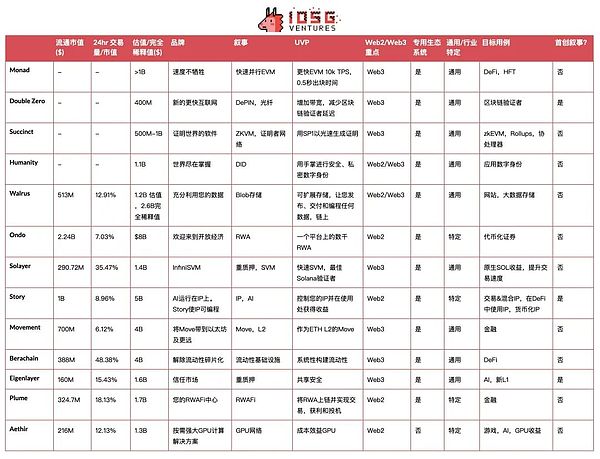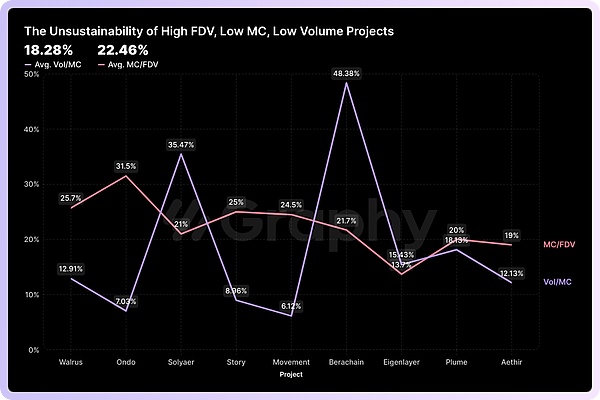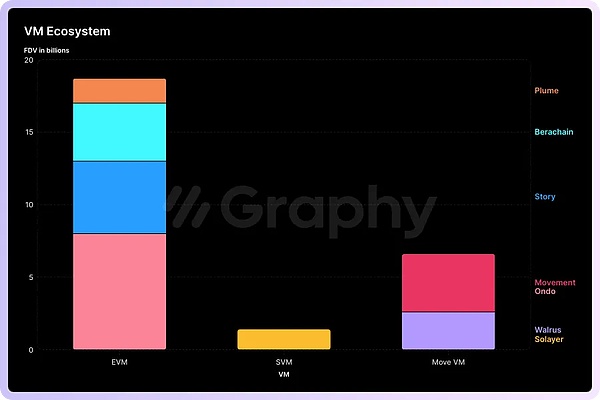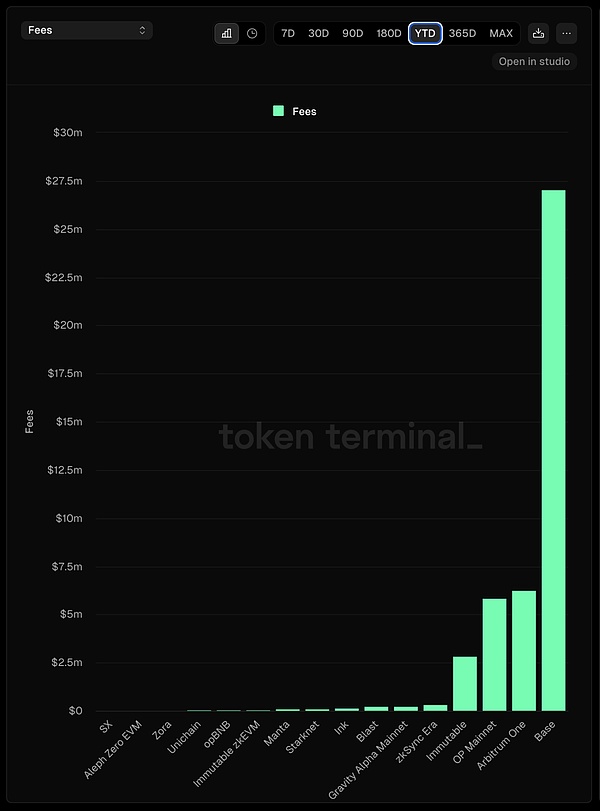Author|Yiping @IOSG
Challenges facing Crypto infrastructure
Market fatigue and declining valuations
The cryptocurrency infrastructure field is experiencing significant market fatigue. After years of explosive growth, infrastructure project valuations are shrinking and investors are becoming more selective. The trend reflects an increasingly mature market where technological innovation alone is no longer enough to earn high valuations.
The Innovation Problem
Today's infrastructure projects face a key dilemma: most provide similar functions with little differentiation. Despite advances in technology, we have yet to see breakthrough use cases that enable entirely new categories of applications. The ecosystem struggles to provide a compelling value proposition for established Web2 platforms (like X or Instagram) to migrate to the blockchain. Beyond decentralization, there is little reason for these platforms to radically change the way they operate. This fundamental adoption gap has made trading and speculation the dominant applications for most infrastructure layers, limiting the transformative potential of the space.
Infra Over-construction and Infrastructure Vacancy
Many infrastructure projects often focus on pursuing forward-looking technological innovation while ignoring the actual needs of developers. They tend to focus too much on elements beyond core functionality, such as privacy protection, trust assumptions, verifiability, and transparency. This overly advanced technology route ignores the importance of short-term market acceptance and practical applications. It not only increases the difficulty of early market promotion, but also makes it difficult for the project to obtain effective user feedback and verification.
The proliferation of such infrastructure projects has created a paradoxical situation — too many platforms competing for too few attractive applications. This imbalance has led to a large number of “ghost chains” with very little actual usage and almost no revenue generation, creating an unsustainable economic model that relies primarily on token appreciation rather than real utility.
For example, although ZKVM technology is quite advanced, the verifiability it provides cannot effectively solve the practical challenges faced by blockchain at this stage, nor can it promote the integration of more Web2 applications and blockchain technology. Therefore, ZKVM technology currently presents itself more as an ideal than an actual infrastructure product.
In contrast, cloud computing directly responds to the proven needs of the market, namely how to efficiently manage server resources with different configurations, different times and locations. This demand itself already has a relatively mature market foundation, and the cloud computing platform directly meets the actual demands of developers in terms of rapid deployment, elastic expansion and cost optimization through modular and interfaced server resources, database management and storage services. Precisely because it effectively solves the pain points of enterprises and developers, cloud computing technology quickly gained market recognition and eventually developed into an important infrastructure supporting the Internet economy.
Breaking the Feedback Loop
A healthy crypto ecosystem requires an efficient feedback loop between application developers and infrastructure builders. Currently, this cycle is broken — application developers are stuck with infrastructure limitations, while infrastructure teams lack clear signals about which features drive actual usage. Restoring this feedback mechanism is critical to sustainable growth. Despite these challenges, infrastructure development remains lucrative, with 35 of the top 50 cryptocurrencies by market cap maintaining their own infrastructure layer. However, the bar for success has been raised significantly — new infrastructure projects must simultaneously demonstrate concrete use cases, substantial user traction, and a compelling narrative to achieve meaningful valuations.
The Most Successful New Infrastructures of the Past Year
The Evolution of Blockchain Infrastructure
Previous cycles of blockchain infrastructure focused primarily on addressing Ethereum’s limitations, with projects positioning themselves as “faster and cheaper” alternatives while offering little in the way of truly innovative features. Today, the landscape has changed dramatically, with recent successful projects introducing more diverse and specialized infrastructure solutions.
Most Impactful New Projects
In the past year, some infrastructure projects have achieved remarkable results through TGE or large-scale financing rounds. According to Cryptorank data, these projects represent the most influential new infrastructure in the primary and secondary markets:
Blockchain infrastructure
Movement: MoveVM Ethereum Layer2
Berachain: Proof of Liquidity, EVM-compatible Layer1 Monad: High-performance EVM-compatible Layer1
Solayer: Heavy staking based on Solana ecosystem, ultra-high-speed SVM
Succinct: ZK proof generation network with ZKVM
Emerging Infrastructure
Walrus: Blob storage solution
Aethir: GPU computing network
Double Zero: Decentralized physical fiber network infrastructure
Eigenlayer: Providing Ethereum security for new protocols
Humanity: Digital identity protocol platform
Web2 and Web3 Bridge
The following is a project data overview table (data as of 2024/4, for reference only):

Core Observations and Analysis
Based on the analysis of recent successful infrastructure projects and combined with the current market environment, the following core observations can be distilled:
Market maturity and valuation reshaping: from technology frenzy to value return

The most notable feature of the current market is the shift in valuation logic. The early model of attracting investment by relying solely on technology narratives and high FDV (fully diluted valuation) is facing severe challenges.
Unsustainable token economic model
Many projects are characterized by high FDV, low circulating market value (MC) and low trading volume. This indicates that the unlocking of a large number of tokens in the future will bring about continuous selling pressure. Even if the project makes technological progress, the price may fall due to token dilution, which will erode user confidence and form a negative feedback loop. This demonstrates that a sound, sustainable token economics model is as critical to the long-term health of the infrastructure as the technology itself.
Valuation ceiling and exit challenges
Even for successful projects, their valuations seem to face an invisible ceiling of about US$10 billion. This means that for investors, getting excess returns (such as 100x) requires entering at a very early stage (valuation below $50 million), highlighting the importance of timing and early judgment. The market no longer readily pays for pure potential, but instead demands clearer proof of value.
Execution overwhelms first-mover advantage
Not all projects that create new narratives receive the highest valuations. For example, while Double Zero, Story, and Eigenlayer are pioneers in their respective fields, many subsequent projects have achieved comparable or even higher valuations through stronger execution, better market timing, or more optimized solutions. This demonstrates the growing importance of high-quality execution, effective market strategies and timing in an increasingly crowded market.
The rise of technological pragmatism: focus on optimization, integration and real needs
The technological development direction of infrastructure shows a clear pragmatic tendency, and the market prefers solutions that can solve practical problems, optimize existing paradigms or effectively connect the real world.
The continued value of “faster and cheaper”
While the market seeks breakthrough innovations, the demand for optimizing core blockchain performance remains strong. Projects such as Monad, Movement, Berachain, and Solayer have achieved significant valuations by improving the performance of existing virtual machines (EVM, MoveVM, SVM) rather than introducing a completely new paradigm. This shows that until the next generation of killer applications is found, improvements in speed, cost, and efficiency remain the core value points of infrastructure. Network layer optimizations (e.g. Double Zero) and security enhancements (e.g. Succinct, Eigenlayer) also fall into this category.

Embrace the real world, connect Web2
Projects that are connected with real-world applications and assets have shown strong market appeal. Ondo and Plume focus on RWA (real world assets), and Story focuses on the programmability of IP (intellectual property). These projects have received high valuations. They apply blockchain technology to proven Web2 concepts (such as asset management and IP commercialization) and inject them with programmability, global liquidity and new financial possibilities, lowering the threshold for user understanding and broadening application scenarios.
DeFi and AI become value anchors
From the perspective of target use cases, finance (DeFi, RWA) and artificial intelligence (AI) are the two areas that are currently most recognized by the market and can support high-valuation infrastructure. This shows that infrastructure that can provide underlying support for these two high-potential areas is more likely to gain favor from capital and the market.
Some new narratives have been cold
At the same time, some infrastructure narratives that were once highly anticipated, such as pure game chains, Rollup-as-a-Service (RaaS), dedicated verification layers, multi-VM chains, Agent chains, some DePIN and Desci, have not yet produced billion-dollar leading projects in this cycle. This may reflect that these areas either lack technological maturity or have not yet found clear, large-scale market demand and sustainable business models.
Eco-synergy and precise narrative: dual engines of value amplification
In addition to technology and market positioning, building a strong ecosystem and conducting effective market communication have become key levers for the success of infrastructure projects
Ecosystem network effects
The vast majority of projects valued at more than US$1 billion are committed to building or integrating into a dedicated ecosystem. Whether it is L1/L2 attracting developers to build applications, or providing shared security for other protocols like Eigenlayer, it reflects the importance of network effects. An ecosystem with multiple composable projects can create value far beyond isolated solutions, forming a positive cycle and attracting more users, developers, and capital.
Layered narrative, precise communication
Infrastructure needs to serve two core groups at the same time: end users and developers, and their needs and concerns are completely different. For end users, complex technologies need to be transformed into intuitive “experience” stories (such as fast transactions, low costs, and ease of use), emphasizing the direct benefits of technology. For developers, it is necessary to explain in depth the "capabilities" of the technology (such as performance indicators, development tools, scalability, and security) and provide professional and accurate information for evaluation. Successful projects often adjust communication strategies according to different audiences and effectively convey value propositions.
Future Investment Opportunities in Blockchain Infrastructure
Targeting Unserved Web2 Markets
The most promising infrastructure opportunities will target large Web2 markets that are not yet adequately served by blockchain solutions. These projects can create globally accessible markets while introducing improved financialization mechanisms.
Creating New Categories of Infrastructure
Rather than incremental improvements to existing infrastructure, entirely new categories of infrastructure will deliver significant value, such as:
Intent-based infrastructure: protocols that enable users to express desired outcomes rather than specific transactions, automatically handling execution optimization.
Adding privacy to every blockchain, HTTPS infrastructure for Web3
Infrastructure that meets user needs and provides stable income
As the blockchain industry matures, the long-term value of infrastructure is gradually returning to its core functions: meeting real user needs and generating sustainable income. Early market enthusiasm may be based on expectations and technical narratives, but ultimately, infrastructure that fails to effectively serve users and build a robust economic model will be difficult to sustain.
A continuous income stream is the blood of the healthy operation of the project. It not only needs to cover the high operating costs, but also provide actual returns to ecological participants (such as token holders, validators), such as for repurchasing tokens, incentivizing participants, etc. At present, some leading L2s such as Base and Arbitrum have achieved considerable protocol revenue. Base’s annual transaction fee is $27.5M, while Arbitrum and OP are around $7M. However, due to changes in investor preferences in this cycle, its token price remains relatively low, reflecting a mismatch between revenue and valuation. Currently, the top Layer2 FDV is 500x the annual protocol revenue. They are fixing this mismatch through measures such as token buybacks.

Lack of income-supported infrastructure, relying more on the sale of tokens to maintain team operations. This strategy is difficult to withstand the fluctuations of market cycles. Stable income is direct proof of the market's ability to solve practical problems and provide effective services. For developers, the infrastructure can implement complex use cases that have been widely used or realize functions that were previously impossible with a hundred times the efficiency; for end users, it can bring a smoother experience, lower usage costs and richer functions.
Web2 APP actively integrates blockchain
Creating revolutionary applications from scratch requires a lot of time and resources. A more efficient approach would emulate the recent AI revolution: integrating blockchain functionality directly into existing Web2 applications. The breakneck pace of AI adoption is being driven not primarily by standalone AI applications, but by thousands of established platforms incorporating AI capabilities into existing user experiences.
Therefore, blockchain infrastructure must prioritize seamless integration paths, enabling Web2 applications to gradually implement blockchain functionality without interfering with their core user experience. The most successful infrastructure will enable familiar applications to provide ownership, transaction, and financial functionality without requiring users to understand complex blockchain concepts or navigate entirely new interfaces.
Financial incentives may be driving this wave of consolidation. Just as AI capabilities help Web2 companies create advanced tiers and new revenue streams, blockchain integration can unlock new monetization models through tokenization, fractional ownership, and programmable royalties. Infrastructure that makes these benefits easily accessible while minimizing technical complexity will catalyze the next phase of blockchain adoption in mainstream applications.
 Miyuki
Miyuki








